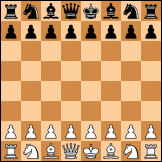We all know that the shortest checkmate from the starting position in chess is the fool's mate, that is, a checkmate in four plies from the starting position.
I asked myself the following question: was a shorter checkmate possible in Fischer Random Chess, also known as Chess960? I think so, so I open this thread in a try to collect all the checkmates in three plies from FRC positions. I will use the numbering scheme from the Wikipedia, where No. 518 is the usual starting position RNBQKBNR.
I think that the only possibility to checkmate in three plies (two moves by white and one by black) is to checkmate in a way like this:
[d]rbkrbqnn/p1pppppp/Qp6/8/4P3/8/PPPP1PPP/RBKRB1NN b KQkq - 1 2
The white piece that checkmates is the queen or a bishop that goes to the sixth rank and the black king is attacked through a diagonal (a6-c8 in the example).
Focusing with the black king on c8 (other cases can be mirrored later to f8 square):
Code: Select all
..k.....2.- The black rook can not be on b8 because it would not be checkmate (2.- ..., Rb7). Rook on a8.
Code: Select all
r.k.....Code: Select all
rbk.....Code: Select all
rbk..q..Code: Select all
rbkr.q..Code: Select all
rbkr.q.nRBKRBQNN (No. 920).
RBKRNQBN (No. 940).
8.- Mirror the positions:
NNQBRKBR (No. 45).
NBQNRKBR (No. 28).
There are two ways of checkmate from each starting position:
1.- e3, b6; 2.- Qa6#. (Positions No. 920 and No. 940).
1.- e4, b6; 2.- Qa6#. (Positions No. 920 and No. 940).
1.- d3, g6; 2.- Qh6#. (Positions No. 45 and No. 28).
1.- d4, g6; 2.- Qh6#. (Positions No. 45 and No. 28).
So, eight possible checkmates in three plies, the same number that the fool's mate in standard chess.
Any corrections are welcome.
Regards from Spain.
Ajedrecista.
